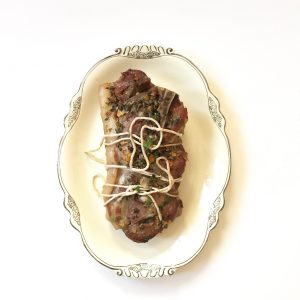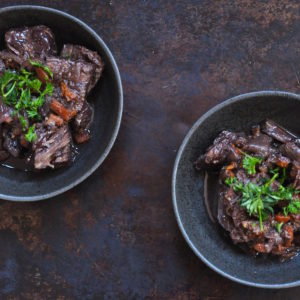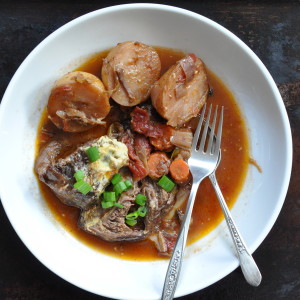Roast Pork with Carrots and Fennel Seed
Roast Pork with Carrots and Fennel Seed represents a womanful effort to make something besides Judy Rodgers’ peerless recipe for Mock Porchetta, which appears in The Zuni Cafe Cookbook.
This recipe asks the cook to create small pockets in the roast along the natural muscle divisions. You then stuff these pockets with a mixture of minced garlic, lemon peel, and fresh thyme. The roast is then tied into a neat shape (or not so neat, if you’re me), salted, and left to collected itself before being roasted inside a protective moat of vegetables.

It’s hard to tear oneself from a recipe like that, but after twenty years I felt I should try. Not that I ventured far: we’re still in Chez Panisse territory, that mythical land where the foods of Italy, Provence, and Northern California commingle at long tables alongside bottles of Bandol rosé.

Not Bandol rosé.
The above is a long way of saying this recipe is a take on Braised Pork Shoulder with Tomatoes, Fennel, and Olives, which comes from Paul Bertolli’s Chez Panisse Cooking.
A few notes…
While the pork benefits enormously from presalting, it’s not required. A teaspoon of salt per pound is what you’re looking for.

We are not big consumers of celery, so I end up freezing it. Frozen celery is limp, watery, and unattractive, but it remains flavorful. Looks aren’t everything.

There is nothing like browning a hunk of meat to make a spattery mess. Unfortunately, it’s worth the hassle, as browning meat bumps a dish like this from nice to spectacular. So open your windows, turn on your oven fan, and invest in a splatter screen.

The splatter screen pictures are awful. So here’s a nasturtium instead.
Dishes like this benefit from a bit of umami. This could be a rind of parmesan, the end piece of proscuitto, or a piece of salt pork.
Any and all root vegetables work alongside the roast. I used two carrots, two potatoes, and lots of garlic.

My roast weighed 2.5 pounds, or just about 1 kilo. In my house this meant two dinners and ample leftovers, which were a boon. Consider stir frying the pork, making fillings for dumplings, pasta, or empanadas; stuffing cabbage rolls, or a delicious if unorthodox banh mi: shred the pork, then add pickled carrots, pickled daikon, a slivered hot pepper, Spam, cilantro, and a smear of mayo (Kewpie, since you ask). Fold these ingredients into a small French roll. The resulting sandwich may be better than the original dish.

Roast pork with carrots and fennel seed may also be taken in a Mexican direction: fill a flour tortilla with black beans, spicy salsa, and either a dollop of sour cream or slices of fresh avocado. Add shredded cabbage or lettuce and cilantro. And, of course, the pork.
I could go on, but you get the idea.

Roast Pork with Carrots and Fennel Seed
Inspired by Paul Bertolli’s recipe for Braised Pork Shoulder with Tomatoes, Fennel, and Olives in Chez Panisse Cooking
Prep Time: Optional presalting takes 1-3 days. Prepping the pork to roast takes about 30 minutes. Actual cooking time depends on the weight of the roast and your oven; 2-4 hours.
Serves: Again, depends roast size, eaters and their appetites; our 2.5 pound/1 kilo roast fed 2 people 2 dinners and numerous lunches.
Please read notes before beginning to cook.
If presalting, 1 teaspoon Kosher or fine sea salt per pound
1 bone-in pork roast, best quality you can afford. Mine weighed 2.5 pounds/1 kilo
A bay leaf (optional)
4 ounces/1/2 cup/120 ml red wine
shot brandy or Cognac (optional)
2-4 Russet potatoes, peeled and chunked
1-2 yellow onions, peeled and roughly chopped
1-4 large garlic cloves, crushed and peeled
1-2 sticks celery, chopped
2-3 carrots, peeled if not organic, scrubbed if organic, and chopped
2 cups/475ml tomato sauce
8 ounces/1 cup/227 ml unsalted chicken broth
A tablespoon tomato paste (optional)
a small piece of proscuitto, Parmesan rind, ham hock, or salt pork (optional)
salt and pepper
1 teaspoon fennel seed
You will need a large ovenproof pot to make pork roast with carrot and fennel seed. A lidded enameled cast iron braiser is ideal, but any heavy pot will do. If the pot doesn’t have a lid, use tinfoil. I used my Staub 5 quart/liter braiser. It weighs more than I do.
You will also need a heavy frying pan to brown the roast and vegetables. It must be large enough to accommodate the roast. I used 12 inch/30 cm frying pan. Seasoned cast iron would work, too.
To presalt the pork: place the roast in a baking pan. Using a teaspoon of Kosher or fine sea salt per pound, rub the meat thoroughly with the salt. Cover lightly and refrigerate up to three days.
When you are ready to cook, bring pork to room temperature. Preheat the oven to 325F/160C.
If your oven has an exhaust fan, turn it on. You might want to open a window, too. Place the braising pot on one burner, pour in a little olive oil, and turn the heat to low. Heat the frying pan to medium high. My roast had a nice layer of fat, so I didn’t add any oil to the pan. If your pork is lean, add a little olive oil to your pan.
Put the bay leaf and potatoes in the braising pot.
Carefully put the pork roast in the frying pan, fat side (if it has one) down. You should hear it crackle. Allow it to brown for about five minutes. Brown does not mean burn; you may need to adjust the heat up or down. When a spatula slides freely under the meat, it is ready to be turned. I do this by gracelessly stabbing a serving fork into one side while sliding the spatula beneath the meat.
Brown the other three sides of the roast. They may need less time. It’s hard to be exact, as all oven, pans, and cuts of pork differ.
Once you’re pleased with the browning, turn the heat down under the pan and move the meat to the braiser.
Carefully pour off any fat accumulated in the pan.
Add the red wine to the frying pan and crank the heat back up to high. As the wine reduces, scrape away at the pan’s bottom to get the browned bits up. When you’re finished, cover the pan with a splatter screen, if you’ve got one, and reduce the wine until it’s syrupy and appears to be about two tablespoons. If you’re using cognac or brandy, add it now, and by all means, set it aflame. Keep the screen off–setting it on fire is a very, very bad idea.
Once the flames die out, turn the heat back down. Add the liquid to the braiser.
Now turn the heat to medium. Add the onions, garlic, celery, and carrots to the frying pan. Give everything a good stir. Season with salt and pepper. Cook gently for about five minutes, stirring occasionally. I don’t aim for browning here so much as flavoring the food with whatever is left in the pan. I didn’t need the splatter screen here, as most of the fat and liquid was gone.
Tip the vegetables into the braiser.
Soak the frying pan. I find adding a little white vinegar helps to clean baked-on gunk.
Now add the tomato sauce, chicken broth, tomato paste (if using; I forgot it), proscuitto, salt, pepper, and fennel seed to the braising pot. Give everything a good stir. Put the lid on the pot and slide it into the oven.
Cooking time will be about 2 hours. Check at half-time: it is doubtful more liquid will be needed. The roast is done when it slices without any resistance whatsoever and the meat looks and smells done.
You can cook the pork roast atop your stove over low heat. It will take much longer to cook; 3-4 hours.
Serve with bread and a green salad.
Leftovers keep, refrigerated, up to five days.
Roast may be frozen up to three months; any vegetables cooked alongside are best eaten, as they become soggy in the freezer.
Notes:
Feel free to add or omit your favorite root vegetables.
Use whatever liquid pleases you. If you don’t have chicken broth, water is fine. So is vegetable broth or light beef broth.
If you abstain from alcohol, broth, water, or apple juice will all work. (Just make sure the apple juice isn’t too sweet.)
As discussed in the post, the small piece of preserved pork or Parmesan end is tossed in for added flavor. While not crucial, it boosts flavor.
I did not have any oil or fat to discard from this dish, but when I do, I pour it into a glass canning jar kept in the refrigerator. Once it’s full, I throw it in the trash. If you have better ideas for dealing with used cooking oils/fats, I welcome them.





